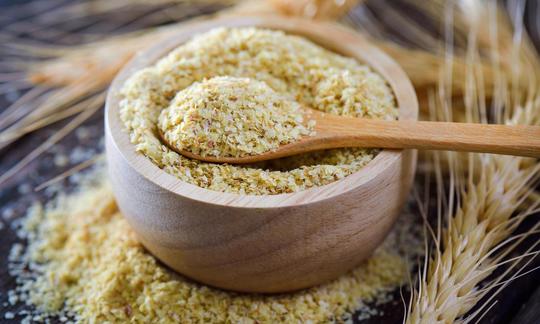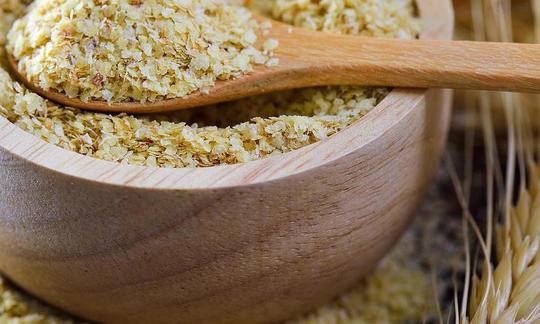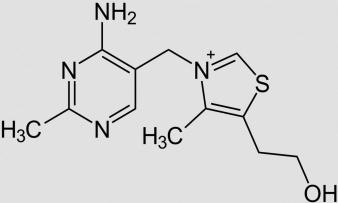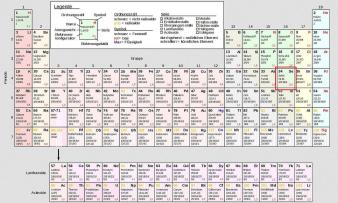Table of contents
Wheat germ is rich in vitamins, minerals, unsaturated fatty acids and proteins. Commercially available wheat germ ( organic ?) is usually subjected to thermal treatment, which is why it is no longer raw .
Use in the kitchen
What is wheat germ? It is the part of wheat grains that has been separated from the kernel and has not yet germinated. It is available commercially dried and crushed in the form of flakes, as granules or ground into fine or coarse flour. Wheat germ tastes slightly sweet and nutty.
How do you eat wheat germ? is a frequently asked question. If you want to eat dried wheat germ, you can regularly add it to your morning muesli ( pea muesli ), soups or vegan sauces. Wheat germ is also a tasty ingredient in smoothies or shakes. You can also simply sprinkle it over a dish with rice , potatoes , vegetables or salads. Wheat germ in baked goods gives bread or pastries a special taste.
In order not to lose the valuable ingredients, we recommend not cooking or heating wheat germ - even though wheat germ is not strictly speaking considered raw food. More information at: "Industrial production".
The food industry makes use of wheat germ or wheat germ flour by replacing the nut content in muesli, sports or chocolate bars. As an ingredient in baking, wheat germ flour improves the binding properties because it binds liquid and thus the products stay fresh longer. In ice cream, chocolate creams or other organic sweets, the use of artificial thickeners can be avoided. In semi-finished soups or sauces, wheat germ flour improves the taste and texture. The protein content of meat substitute products can be increased with wheat germ. 1
Please do not confuse this ingredient with germinated wheat (wheat germ), wheat sprouts or wheat bran . For details, see "Possible confusion".
The oil obtained from wheat germ, wheat germ oil, contains many unsaturated fatty acids and is very sensitive to heat (low oxidation stability), which is why it is only used to refine dishes and not for frying or baking.
Vegan wheat germ recipe for a green smoothie
Ingredients (for 4 people): 6 kiwis (green) , 1 liter drinking water (cold), 1 teaspoon wheat germ (organic), 1 teaspoon matcha powder, 4 cocoa beans (raw) , 30 g fresh ginger , sweetener as needed (e.g. agave syrup , maple syrup ).
Preparation: Peel the kiwis and raw ginger, cut into pieces and mix finely (puree). Then add the other ingredients, top up with cold water and mix again for about 1 minute. If kept cool and mixed again before serving, the vegan wheat germ smoothie tastes particularly good.
Vegan recipes with wheat germ can be found under the note: " Recipes that have the most of this ingredient ".
| Not only vegans or vegetarians should read this: Vegans often eat unhealthily. Avoidable nutritional mistakes . |
Purchasing - Storage
You can find wheat germ in well-stocked supermarkets such as Coop , Migros , Rewe , Edeka . Other large retailers (e.g. Denner , Volg , Spar , Aldi , Lidl , Billa , Hofer etc.) do not stock it as part of their standard range, but may do so as part of special offers. Online retailers also offer wheat germ in raw food quality, but there is no quality seal (label) for this. Find out more, because really fresh (raw) wheat germ does not last long. Thermally treated wheat germ can be stored for longer without refrigeration, which is why we assume that most products in stores are stabilized.
In health food stores, organic shops or organic supermarkets ( Alnatura , Denn's Biomarkt ) you will definitely find organic wheat germ. Make sure that the organic wheat germ is not roasted or enriched with ingredients such as vitamins or trace elements (selenium, iodine).
Wheat germ is available as fine or coarse flour, as flakes or granules, sometimes also referred to as wheat germ meal. When food supplements are advertised as containing the ingredient "spermidine" from wheat germ, it is usually a fine powder, eg in capsules.
Are there any wheat germ test winners? Wheat germ, wheat bran and wheat sprouts are highly competitive products and there are also so-called "test winners". Provided that the products are not contaminated and free of harmful substances, criteria such as organic quality, raw food quality and price should be evaluated depending on personal needs.
The availability of wheat germ varies depending on the size of the store, catchment area, etc. Our recorded food prices for the DA-CH countries can be found above under the ingredient image - and by clicking you can see their development at various suppliers.
Storage tips
Wheat germ does not last very long when raw and without stabilization due to its high content of unsaturated fatty acids. When the industry uses so-called gentle partial defatting, important nutrients are lost. However, this defatting and subsequent drying of the wheat germ (moisture content < 5%) can extend the shelf life to a year or more when kept in closed packaging.
Storage tip: You should store both wheat germ and wheat bran in the refrigerator so that they do not quickly acquire a rancid taste - especially with organically produced wheat germ in raw food quality. In general, opened packages should be consumed quickly - and if possible, transferred to airtight containers (eg screw-top jars).
Ingredients - Nutritional values - Calories
The germ is the part of the wheat grain that is richest in vitamins and minerals. Wheat germ contains 9.7 g of fat and 52 g of carbohydrates per 100 g and has a considerable calorie content of 360 kcal/100g. Wheat germ is also characterized by a high protein content (23 g/100g), 2 with the protein having a good biological value.
The trace element manganese is the most important with 13 mg/100g: 15 g of wheat germ (approx. 1.5 tablespoons) therefore cover the normal daily requirement. However, please note the consumption recommendation in the "Health aspects" chapter. Cinnamon has a similar content with 17 mg/100g and cloves have a multiple of this with 60 mg/100g. 2
Selenium is also well represented at 79 µg/100g, similar to Kamut (82 µg/100g). Brazil nuts contain far more selenium at 1917 µg/100g: 2 nuts are enough to cover the daily requirement. The content of this trace element depends on the growing region. 2
In addition to B vitamins ( thiamine and pyridoxine ), wheat germ also contains folic acid (281 µg/100g). Yeast flakes have a similar amount (300 µg/100g). 2
100 g of wheat germ contains around 23 mg of vitamin E in the form of tocopherol. 7,12 The daily requirement of this vitamin is 12-15 mg. Almonds have slightly more at 26 mg/100g and sunflower seeds at 35 mg/100g. 2
The ratio between the unsaturated essential fatty acids linoleic acid (omega-6) and alpha-linolenic acid (omega-3) in wheat germ is 7:1, which is very close to the recommended ratio of 5:1.
EE: People who eat in the West get a very unhealthy ratio of omega-6 fatty acids to omega-3 fatty acids. Originally, people ate the only two essential fatty acids in a ratio of about 1:1 to 2:1. Today, people try to consider 5:1 as healthy because vegetarians in particular can get up to a ratio of 17:1, meaning they potentially consume 17 times more inflammatory omega-6 fatty acids (LA) and very little ALA, the omega-3 that serves as a precursor for the formation of EPA and DHA . 18 You can find more information about this in our ingredient olive oil .
The complete ingredients of wheat germ, the coverage of the daily requirement and comparison values with other ingredients can be found in our nutrient tables. In the article Nutrients explained you will get a detailed insight into the topic.
Effects on health
Are wheat germs healthy or unhealthy? Wheat germs are often sold as a superfood, although most natural foods could be called superfoods. But how healthy are wheat germs? The B vitamins contained in wheat germs help with nervous system disorders, such as fatigue, depression, stress or nervousness. Wheat germs can be helpful for high blood fat levels and coronary artery disease. The vitamins contained in wheat germs (B 1 and E) also have a blood sugar-lowering effect and can help with diabetes. Wheat germs are ideal for people with increased nutritional needs such as athletes, pregnant or breastfeeding women or those under exam stress. 3
According to epidemiological studies (2010), whole grains protect against obesity, diabetes, cardiovascular disease and cancer thanks to their satiating effect, improved digestion and glycemic response. The bran and germ components in particular have antioxidant and anti-carcinogenic properties. 7
When mice were fed spermidine, a drop in blood pressure and an associated lower risk of cardiovascular disease was observed (2016). 10 Results of a long-term observational study on humans (20 years) from 2018 show that people with regular spermidine intake lived 5 to 7 years longer (mortality rate). 11
How much wheat germ should you eat per day? 5 g of wheat germ daily means a dose of 1.2 mg of spermidine (not spremitin). For example, in the morning in Erb muesli , which is then no longer guaranteed to be 'gluten-free and raw'. From experience, we recommend not to exceed a daily intake of 10 g (approx. 1 tablespoon) and to make sure it is organic. In order not to overburden the intestines, you should also introduce days without wheat germ and pay attention to the effect on the intestines.
Fermented wheat germ extract was used in eight known studies (2017) to increase the effectiveness of chemotherapy and radiotherapy in tumor patients, reduce side effects and improve people's quality of life. There were certainly positive results, but the evidence for effectiveness was too low to classify the therapy as successful. 4 The dietary supplement industry promotes this extract for strengthening brain cells and mental balance or as a vital substance against oxidative stress.
Does wheat germ help you lose weight? The amount used and the daily calorie consumption are particularly important here, as wheat germ tends to add calories to dishes. We were unable to find any scientific studies on whether the spermidine it contains helps you lose weight.
Secondary plant substances
Many of the health effects of wheat germ can be attributed to the secondary plant substances it contains. Our article on secondary plant substances provides an overview of the classification of substance groups, their occurrence in foods and possible effects on humans. Wheat germ contains the following secondary plant substance:
Wheat germ contains spermidine, a biogenic polyamine. Research (2013) shows that feeding fruit flies spermidine suppresses age-related memory disorders. The memory processes in animal organisms (e.g. flies and mice) are similar to those in humans on a molecular level. With these findings, researchers hope to be able to develop remedies against the onset of dementia. 9
Dangers - Intolerances - Side effects
Beware of too much wheat! More and more people are gluten sensitive and suffer from intolerance to wheat proteins and wheat gluten. This is also why Erb-Müesli uses seeds instead of grains.
Does wheat germ contain gluten or is wheat germ gluten-free? Gluten is the protein in the endosperm of wheat and many other types of grain. Therefore, the germ is actually gluten-free. Due to the mechanical processing, there is a high probability that wheat germ also contains gluten. Gluten intolerance, which causes autoimmune reactions such as celiac disease, is mainly caused by the gliadins (prolamins) 17 contained in gluten. If you have celiac disease, you should even avoid organic fresh yeast and organicdry yeast when choosing foods, because these are grown on a grain medium.
Wheat germ and other products containing wheat can cause cross-reactions if you have a wheat pollen allergy (or other grain pollen allergies). You can read more about wheat allergies in our ingredient wheat grains .
For people with gout symptoms, large amounts of wheat germ are unhealthy because they contain uric acid-forming substances. 13
Wheat, particularly wheat germ, contains the anti-nutrient lectin, which acts as a natural insecticide in plants (wheat germ agglutinin, WGA). 17 It is also written: GlcNAc-β1-4-GlcNAc-β1-4-GlcNAc or 5-acetyl-neuraminic acid (Neu5Ac). Lectins are also found in much smaller quantities in other plants (e.g. tomatoes and potatoes). In contrast to the lectin in legumes, WGA is heat-stable and resistant to proteolytic digestion (degradation of proteins). 6
Does wheat lectin make us sick or harm us? It is always a question of the amount and genetic disposition, age, etc. whether something is harmful or beneficial. In high concentrations, lectins can promote the development of intestinal diseases or intestinal damage such as Crohn's disease or even rheumatoid arthritis. 6 Wheat germ tests have shown that wheat lectin can seriously damage the intestinal mucosa of rodents if they are fed it in too large quantities. Too much lectin can lead to headaches, vomiting, diarrhea and stomach and intestinal complaints, which disappear after a few hours. Since the body cannot break down the wheat germ lectin with its own proteases, there are fears that regular consumption will affect the functions of the pancreas and the immune system. 8
Results from studies of dietary lectins show that wheat germ agglutinins are toxic to acute myeloid leukemia cells, which is why it is hoped that they will have an effect in leukemia therapies. 16
Ecological footprint - animal welfare
An automatic calculation (without specific production data) came up with a CO 2 footprint of 1.22 kg CO 2 eq/kg for wheat germ. Wheat germ flour (German product) came up with 2.37 kg CO 2 eq/kg. 19 These are relatively high values for plant-based products; comparable to dried lentils (1.2 kg CO 2 eq/kg), peanut butter (2.0 kg CO 2 eq/kg), coconut oil (2.3 kg CO 2 eq/kg) or seitan (2.5 kg CO 2 eq/kg). 24
The starting product of wheat germ, the wheat grain , has a CO 2 footprint of 1.06 kg CO 2 eq/kg; similar toblueberries (1.03 kg CO 2 eq/kg) or cherries (1.01 kg CO 2 eq/kg). 20
The water requirements and yield of wheat depend on the climatic conditions of the growing area. On average, grain has a water footprint of 1644 l/kg; wheat needs as much as 1827 l/kg; wheat flour , from which the wheat germ is usually removed, comes to 1849 l/kg. 21 This is far more water than the average need for growing vegetables (322 l/kg) or fruit (962 l/kg); but the water footprint can still be classified as good. Nuts (9063 l/kg) or meat (e.g. chicken 4325 l/kg or beef 15415 l/kg) have a much larger footprint. 22
For detailed explanations of various sustainability indicators (such as ecological footprint, CO2 footprint, water footprint), see our article: What does the ecological footprint mean?
Animal welfare - species protection
Agriculture is one of the most important factors in the rapidly increasing loss of species. After soy, wheat is the crop with the largest biodiversity footprint. This is partly due to the fact that wheat cultivation requires a very large amount of land. 23
Worldwide occurrence - cultivation
Today's seed wheat comes from crosses between several types of grain (wild einkorn and wild emmer) and wild grass species (goosefoot grass). 14 It probably originates in the north of the Arabian Peninsula (Fertile Crescent). 15
You can find out more about the cultivation and harvesting of wheat (organic and conventional) under the ingredient wheat grains .
Potential for confusion
The terms germ and sprout are often unclearly separated, which causes confusion. Distinguish between wheat germ and wheat sprouts . Wheat sprouts are the whole grain in the germination stage. Depending on the length of the germination period, the young plants are then called wheat sprouts or wheat grass. You can find out more about "eating wheat sprouts" under Wheat, sprouted .
Wheat bran , on the other hand, is the residue of the husk, aleurone layer and grain germ (also called germ) that remains after the flour is milled and sifted.
Industrial production
When producing white wheat flour, the wheat germ is separated from the endosperm because of its high oil content. This gives the white flour a lighter color and a longer shelf life. With wholemeal flour, the germ is left in or added back in later.
Wheat germ (and its products) require a stabilization process for a longer shelf life. This also prevents butyric acid fermentation (rancid taste). A (hydro)thermal treatment is used for stabilization. A reduction of the water content to 5% is considered ideal. 5 This is why wheat germ with a longer shelf life is no longer raw, but heated. Depending on the process and temperature, however, important vitamins (B 1 and E) and enzymes are retained. 5 The trade offers full-fat-stabilized or defatted-stabilized wheat germ (usually flakes or granules), although these names vary depending on the manufacturer.
Further processing: Using a cold-pressing process, the oil is pressed out of the wheat germ and contains wheat germ oil as well as the by-product wheat germ press cake. After drying and grinding the press cake, defatted coarse or fine wheat germ flour can be obtained from it. However, wheat germ flour is also available as a full-fat stabilized variant. 1
Further information
A wheat grain ( Triticum ) consists essentially of endosperm (about 80% of the weight), fruit and seed coat and the germ after the outer shell has been separated as an indigestible husk. The wheat germ makes up only a tiny part of the mature wheat grain, 2.5%. The wheat grain contains the fertile germ (embryo), which is needed for a wheat plant to grow.
Alternative names
The English name is 'wheat germ'.
Other uses
Wheat germ and wheat germ oil are also used externally for skin and hair treatments.
Bibliography - 8 Sources
| 1. | USDA United States Department of Agriculture. |
| 2. | Wikipedia Weizen. |
| 3. | Roger JDP. Heilkräfte der Natur. Ein Praxishandbuch. Zürich: Steinmeier GmbH. 2006. 296. |
| 4. | Wikipedia Spermidin. |
| 5. | Dr. med. William Davis, Weizenwampe. Warum Weizen dick und krank macht (Buch). Goldmann Verlag. 2013. |
| 6. | Cordain L et al. Modulation of immune function by dietary lectins in rheumatoid arthritis. British Journal of Nutrition 2000;83:207-217. |
| 7. | Fardet A. New hypotheses for the health-protective mechanisms of whole-grain cereals: what is beyond fibre? Nutrition Research Reviews 2010;23:65–134. |
| 8. | Pusztai A, Ewen SW, Grant G, Brown DS, Stewart JC, Peumans WJ, u. a. Antinutritive effects of wheat-germ agglutinin and other N-acetylglucosamine-specific lectins. Br J Nutr. Juli 1993; 70(1): 313–21 |










Comments